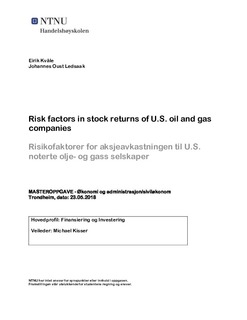| dc.description.abstract | In this paper, our objective is to examine if the oil price contributes to explain the return of the oil companies. We analyze a total of 184 U.S. stock exchange listed oil and gas companies, divided into six different subsectors. Our dataset consists of monthly observation from April 1983 to December 2017.
First, we have examined oil and gas related companies’ sensitivity for changes in the oil price after adjusting for known risk factors. After comparing the different models, we have tested if the results are valid in different subsectors and through different time periods. The findings suggest by comparing the models by adding oil price to the CAPM and Fama-French model, that the oil price is significant and adds explanatory power to both models. The significant results of the oil coefficient are also valid when testing the different subsectors, where all subsectors show that they have significant exposure for changes in the oil price. This result is also persistent when we test different time periods.
Second, we have used the Fama-Macbeth procedure to examine whether the change in the oil price is a priced factor. The results from our study seems to show no signs of evidence that the oil beta is a priced risk factor | nb_NO |
